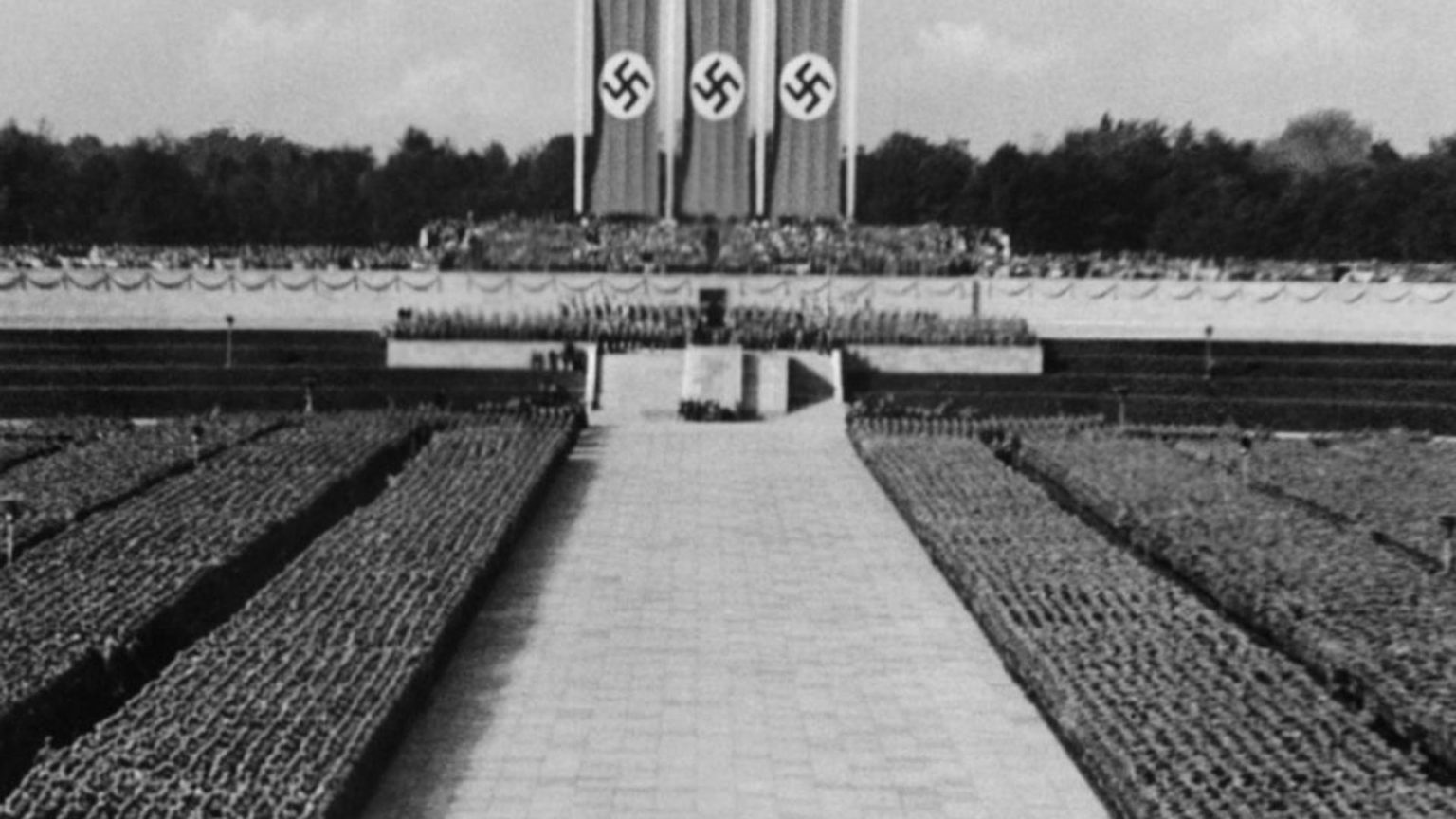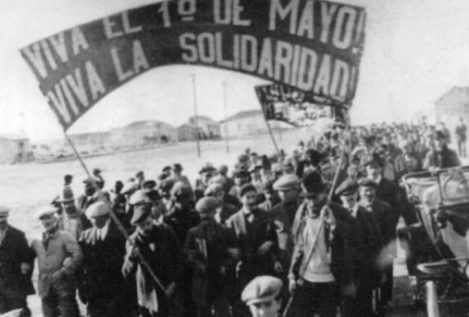From Hitler to Lombard
«Riefenstahl took full part in the preparations for the Nazi convention, designing her own sets and choreographing the performance; the film’s impact on the world was, after all, of greater importance than the impression the convention made on witnesses and those who attended»

IMDB
Although her name doesn’t always come up when we speak of female film directors, the German director Leni Riefenstahl was responsible for the most impressive film ever made by a woman: her Triumph des Willens, which showed the world the convention the Nazi Party held in Nuremberg, where 700, 000 members or sympathizers of the National-Socialist movement congregated back in 1934. With good reason the critic David Thomson establishes a seductive comparison between Riefenstahl’s fascism and any film director’s vocation for authoritarianism, calling attention to the fact that the real triumphant will is in this case Riefenstahl’s. It belonged to a Berliner who was then just barely 32 years old and who brought an intimidating mass of National-Socialists under her control, including Hitler and his lieutenants.
It is a film that deserves to be seen and that it is a good idea to see, which are two different things. It deserves to be seen because it is a spectacle of the first order, that features a prodigious mise-en scène and sets before our eyes the unsettling beauty of the masses in movement. And it is a good idea to see it, aside from its historical interest, in order to acquaint oneself with the persuasive power that political propaganda aimed at the other masses could achieve: those masses that listened to Hitler’s speeches on the radio and who went to the cinema to The Triumph of Freedom after its premiere in Berlin in March 1935. In two months the film had brought in box-office receipts equivalent to three million euros today. Seven years after the official birth of the talkies, even though it was twenty since Griffith had made the controversial Birth of a Nation, the new art of motion pictures lent its services to the National-Socialist cause. In our times, which are saturated with screens, films lack that old power. You have to put yourself in the shoes of a German citizen who was going to the movie theater to see this mock documentary on the big screen: the impression must have been incredibly vivid, either euphoric or terrifying, as the case might be, and perhaps life-changing.
I say «mock documentary» not because all documentaries have something false about them but rather because Riefenstahl took full part in the preparations for the Nazi convention, designing her own sets and choreographing the performance; the film’s impact on the world was, after all, of greater importance than the impression the convention made on witnesses and those who attended. A team of 150 people and up to 36 cameras were made available to her and there is no doubt that Riefenstahl more than met the terms of what she had been commissioned to do by the Nazi leaders. The film has some dull moments, to be sure, and it loses some impact as it proceeds, weighed down in its final section by the overly long military parade through the streets of Nuremberg. But these highs and lows, which may not have been felt as such by the German public of the time, are more than made up for by the prodigious power of many other sequences. I’ll mention only the best two, which make it clear how much of a genius Riefenstahl was and how great cinema’s ability is to enthrall viewers —at least, of course, while they sit in front of the screen: if perfect hypnosis were possible, by now we would have been living for some time under an eternal dictatorship and, no matter how much Debord might insist on the society of the spectacle, fortunately that is not the case.
The Triumph of the Will has a memorable beginning: solemn music plays, we see clouds, we are on board a plane. The apparatus begins its descent from high over a city of sharply pointed medieval roofs, projecting its shadow over them; a shadow that the camera manages to capture under the fitful Bavarian sun. When the plane lands, the crowd gathered in the airfield salutes with fervor: a hale, fair-haired Hitler, who was then 45 years old, steps from the plane followed by the lean figure of Joseph Goebbels. The Führer then climbs into an open-roofed car with which he will tour the streets of the city, in full-dress and standing at attention, responding to the Germans; Nazi salute as they fill the sidewalks: while they stretch out their arms. Hitler cuts a ninety-degree angle with his forearm and his hand falls back slightly with a hint of languor— it must be exhausting to spend the entire day saluting. The surprising thing is, we spectators follow him on his route, just behind him, with the camera placed at a perfect angle to allow us to see him saluting the crowd. When we see a shot of the car from another position, however, the camera doesn´t appear anywhere: a surprising trick on the director’s part. There’s a moment when the car stops, because a woman is coming up to the Führer with a baby in her arms in order to give him a bouquet of flowers. Hitler gets out of the car to greet her and to fuss over the child; we see the woman’s eyes fill with admiration and we wonder if she and her child survived the war that would break out only five years later. The sunlight falls on both of them. Hitler goes on his way amid hands outstretched to the sky and, as Thomson points out, the scene seems to be from right out of a newsreel, when it is, from all indications, a calculated and rehearsed moment: fiction disguised as history.
Later, we go to the Zeppelinwiese, the airfield for zeppelins, a space devoid of great dimensions where Hitler prepares to review 52,000 members of the so-called Imperial Work Service. Their leader, Konstantin Hirl, accompanies the Führer to the podium and reports to him in a booming voice that the workers are ready for inspection. Hitler, speaking always at a certain remove from the microphones, addresses them to show his satisfaction and to single them out as the foundation of a new Germany whose young men must come up through the organization. And then something unexpected happens, which a virtuoso montage conveys in a precise rhythm: an officer inquires with clear
diction: «Comrade, where are you from?», and different members of the group begin to answer, mentioning their place of birth: «From Frisia!» «From Bavaria!» «From Pomerania!» When the enumeration is over, all of them —and they are many— sing in martial cadences: «One people, one Führer, one Reich, one Germany!». This is followed by a succession of brief close-ups of Hitler’s face, the Eagle, the flag with Nazi insignia on it. And a dialogue begins between the officer and the mass of workers: when the first one leads by saying «we all work together!», a group of workers respond, saying «in the fields», while another group adds «in the quarries», then another says «we plant trees», and the choir adds «thousands of trees!». All this while the camera moves from close-ups to group shots, until the trumpets sound and they all sing a short song, in tune with the music, which is brought to a close by a solemn drumroll. The official acting as the spokesman for the collective body explains to the Führer that they were never able to fight in the trenches «nor hear the explosion of grenades», but, despite it all, they are soldiers. «With our hammers, our axes, our shovels» they chime in. The funereal trumpets sound, they raise their arms in salute, and the tragic battle scenes of the Great War are called up as the Nazi flags are ritually lowered to the ground: «Verdun, the Somme, the Danube, Flanders Fields». The soldiers wear a determined look; they bear shovels instead of rifles. A voice is heard: «Comrades all of you who fell in battle», then more drumrolls: a close-up of the officer with the impeccable voice, who is shouting to his men: «You are not dead, you are alive! You are Germany!» And then, only then, does Riefenstahl give us the shot of the entire assembly which she had been withholding, switching to Hitler’s face and back, as he offers a brief final speech in which he emphasizes his pride and the pride of all of Germany. The viewer has been left dumbfounded.
Although Riefenstahl stated on many occasions that she had been guilty of naiveté where Nazism was concerned, which cannot be entirely ruled out if we consider how many believers fascists, National-Socialists and communists gathered to them at first, her film is a powerful tool of persuasion in the service of a sinister cause: the confusión of the Führer, the movement, the State and the party; a call for cultural and ethnic homogeneity; an exhibition of popular unity and charismatic leadership; a vindication of the homeland that rises proudly after the humiliation inflicted on it by the allies at Versailles; a vocation for cleansing and order after the failure of Weimar; the need for discipline and morality; the melting of the individual into the people’s national body, subordinated, at the same time, to movement and leader; an exaltation of force and the will power alluded to in the title. All this is conveyed through images and symbols, which in this Triumph reinforce the explicit message —astutely devoid of anti- semitism — that the Nazi officials deliver as they climb onto the stage to read their respective speeches, although without the dramatic magnetism of their supreme chief: the one who seems to wrap his arms around himself, in a convulsive gesture, when the audience acclaims him.
Of course, this Triumph is not the only connection between cinema and Nazism, although it is the most explicit. Recall, if you will, that Lotte Eisner argued in her well-known essay, The Diabolical Screen, that film expressionism, characteristic of silent German film, fed on Romantic myth and came in response to a society overwhelmed by the collapse of empire and the failure of the democratic republic. She called attention at the same time to the way Riefenstahl borrowed aesthetically from this tradition to carry out her idealizing and monumentalizing mission. Sigfrid Kracauer, for his part, called on Marxism and psychoanalysis in his monograph, From Caligari to Hitler, to make the claim that there was a causal link between German expressionism and the rise of Nazism. Kracauer’s premise is that the popular films satisfy real desires on the part of the masses, even if these desires are not so much explicit creeds as more or less unconscious strata in the collective mentality. From this point of view, The Triumph of the Will condenses and makes these tendencies explicit, which may be pyschological or cultural but come to be political. Mediated by aesthetics, German social reality —stresses Kracauer— is adulterated and harnessed to a cause. That is why the film is so uncomfortable to some and its images suggest dementia to Eisner. It may have been for this reason that YouTube has decided to ban it, on the understanding that a black and white film, 100 minutes in length, can still be dangerous today, though they may in doing so only reinforce its appeal.
After coming into contact with this claustrophobic and unanimist world, no antidote seemed better to this film buff than to see for the umpteenth time what is of course the best comedy ever: To Be or Not to Be. The edition available to me was an incentive in itself, for the version put out by Criterion in Blu-Ray in 2013 delivers a digitally restored edition in 2K. I can´t remember how many times I have seen this film in versions that were lacking and on small TV screens, before movie projectors reached the general public. That classic cinema has survived the conditions in which it had to be viewed, outside of theaters, is testimony enough to its quality. It’s a different thing altogether whether that audience will still be there in the Netflix era; this rich and subtle language might possibly become incomprehensible to the majority of digital natives. If that were to happen, they wouldn´t even know what they were missing. It’s hard to say whether this is a consolation or part of the misfortune.
Ernst Lubitsch, a jew from Berlin and the son of a tailor, devoted his life to crafting a sophisticated and intelligent cinema that celebrated the joy of life and the essential openness of existence. Although he died when he was only a little over 55, the victim of a weak heart, he lived long enough be a star in Germany and in Hollywood, to master the language of silent cinema and to adapt successfully to the talkies. He filmed epic-type historical cinema; he took John Barrymore to the Rocky Mountains to make an alpine drama; he adapted Oscar Wilde’s Lady Windermere’s Fan almost without subtitles; he filmed delightful musical operettas in the first years of the sound era; and he shaped the smart comedy of the 30s cultivating a distinctly different style from the screwball comedy of the master, Howard Hawks. He was a perfectionist who even had a hand in designing costumes, though he got on well with the actors (even if he quarrelled with the powerful Mary Pickford) and he left a certain scope for improvisation. He founded an association for the reception and integration of film professionals who emigrated to Hollywood after the outbreak of World War II, though he himself had landed there —like so many other of his countrymen, among them the very Murnau—before Nazism’s rise to power. Despite the clout of the UFA and the splendor of German cinema between the wars, few took the call of Hollywood lightly. There are even reasons to allege that Lubitsch was the German emigré who adapted most quickly to the Californian dream factory, where he soon made a name for himself —especially in Paramount, where he had a serious disagreement with Josef von Sternberg— to the point of being one of the first directors whose name was featured in studio publicity. In fact, it has been said that Ninotchka (1939) and To Be or Not To Be (filmed in 1941, before the United States entered the war, and released in 1942) are films that Lubitsch could only carry off thanks to the significant presence of emigré actors and technicians: from Greta Garbo to Felix Bressart or Bela Lugosi, including the musicians Werner Heymann and Miklos Rozsá, the producer Alexander Korda or the director of photography Rudolf Maté. It is a well-known fact that classic Hollywood never had anything American about it; or, rather, that in its promiscuous hybridity, it had everything American about it.
We have to bear in mind that Nazism was hardly spoken of in Hollywood in any explicit way until the United States got into the war after the Japanese attack on Pearl Harbor That was, among other things, because the German market was such a prize and no studio wanted to suffer the consequences of losing a foothold in it. Only Warner Brothers, prompted by its founders’ anti-Nazi consciousness, made some effort to denounce, more or less obliquely, how dangerous Hitlerism was. There you had Bogart, who joins an organization of American «patriots», devoted to the hunting down of the foreign enemy, in Black Legion (1937). And there is another exception, like The Mortal Storm (1940), in which Frank Borzage takes James Stewart and Margaret Sullivan (the wonderful couple in Lubitsch’s exceptional film The Shop Around the Corner) to an Alpine locale where social ties fray after the electoral victory of Nazism. But the focus of these films, oriented around solemn denunciation, has nothing to do with Lubitsch, who is going to be true to himself by situating the critique of totalitarianism in the realm of satire: he goes after Communism in Ninotchka and after Nazism in To Be or Not to Be (Wilder will laugh at them both in One, Two, Three). Although Nazism also rears its head for one memorable moment in the first of these two masterpieces: when the three Communist commissars arrive at the train station in Paris, they think that their contact is a middle-aged man with a heavy beard, but this man suddenly finds himself face to face with his wife and both give a Nazi salute…It is all part of the joke that political fanaticism leads a married couple to meet up with each other again in this way.
Some people have reproached Lubitsch for seeeking refuge in a cosmopolitan world of aristocrats and parvenus where life sparkles, as if in a bubble cut off from the turbulent social world of the 20s and 30s. There’s something of that, of course; his world isn´t exactly the world of social realism. But it would be a mistake to conclude thereby that Lubitsch did not acknowledge what the existing reality was beyond the screen, or that he was helping to build an ideological trompe-l’oeil in order to maintain the status quo. To put it simply, this Berlin jew wanted to give shape to his own reality and to affirm the value in it of irony, elegance and good intentions. Everything, including robbery, is done with a smile in his cinema; tears are dried with a certain effortlessness and optimism emerges as a creative force. Nevertheless, toward the end of the 30s and beginning of the 40s, political reality came to form part of his moviemaking. In the delightful Cluny Brown, for example, resistance to Nazism and a critique of the British class system appear on screen.
And yet, To Be or Not to Be is something else again. Dirty reality erupts here with more force than in any other of his films, even if it is in the terms dictated by Lubitsch. Averse to any solemnity, our man from Berlin wants to make the Nazis look ridiculous and, with a sense of humor, show the moral superiority of what the Nazis want to do away with. As we know, the film was not a hit at the box-office, with the American audience already focused on the war effort and patriotic propaganda, nor did it earn the applause of critics who proved unable to understand it. And so, this perfect comedy, which can be seen again and again without exhausting any of its subtlety, was slighted at the time of its release. Here you have a reason why no one should ever think that the last word has been said about a work of art.
Its plot is not easy to summarize. Few films make such an exhaustive use of the time at their disposal —barely an hour-and-a half— to introduce so many subtleties and twists, with the peculiar circumstance that the majority of them are variations on what went before, so that the story seems to be building on itself. The first thing we see is Hitler walking through Warsaw, while a voice in off asks how can that be possible when Nazi Germany has threatened Poland with invasion. A quick flashback takes us to the office of the Gestapo, where a child is being gently interrogated about his father’s political sympathies. A comic device crops up here that will be exploited all throughout the film; the Nazi salute, accompanied by the predictable Heil, Hitler!, used by the characters to get out of tight spots. In this case, the official says it when his political loyalty comes under suspicion, at the moment the arrival of the Fuhrer is announced, whose response is memorable: «Heil Myself!». It is the same Hitler we have just seen in the street, but we hear someone off-camera shout, «No, no, that is not in the script!». It’s the director of a theatrical troupe that is rehearsing Gestapo, a new work, while they stage Hamlet. In order to show that his Hitler is credible, the actor plunges into the streets of the Polish capital, where a crowd mills about him… until a little girl asks him for his autograph.
In this initial scene the troupe is introduced, including the leading actors: the vain Josef Tura (memorably played by Jack Benny) and the no less vain Maria Tura (the unforgettable Carole Lombard, who had already played an actress in that fierce and extraordinary comedy Twentieth Century by Howard Hawks and who would die before the release of To Be or Not to Be, prematurely, at the age of 32, when the plane in which she was travelling, on a mission to sell war bonds, crashed near Las Vegas). Both are going to drive the action in the film, together with the young Polish aviator, Sobinski (Robert Stack) and the rest of the theatrical troupe, which includes an unpaid extra (Felix Bressart) who dreams of playing Shylock («all we do is carry a spear back and forth»). Even before war breaks out, a love triangle emerges —Lubitsch’s favorite device— formed by the two Turas and the Polish officer, who woos the famous actress. Both meet in the dressing room while Hamlet’s soliloquy is being performed by the husband, who is traumatized by the fact that someone could leave their seat in the theater when he begins to declaim. Here there is another unbeatable joke: when Josef Tura, book in hand, approaches the edge of the stage, the prompter whispers to him… the most famous lines in the history of theater: «To be or not to be». But when one of those performances is drawing to a close, the news arrives that Hitler has invaded Poland. The performance of Gestapo is banned and Sobinski joins the Polish squadron of the RAF. That is where he discovers that Professor Siletsky (Stanley Ridges) has committed treason: he is a double agent who will visit Warsaw with the secret aim of doing away with the anti-Nazi resistance in the capital. From then on there is a memorable play of ambiguities and impersonations whose purpose is all to stop Siletsky; the task falls to the theatrical troupe, who uses means all its own to carry this off, building sets and characters that make it possible not just to neutralize Siletsky but to get out alive as they do so. All of the Nazis the company runs into are portrayed as inept clowns, with the hilarious Captain Schultz (Henry Victor) earning special mention. Siletsky is the exception: he is truly dangerous and lacking in all humor, as if Lubitsch and his scriptwriter Edwin Justus Meyer wanted to give us the atrocious reality behind Nazism before they continued to laugh at it. Siletsky’s death in the theater, incidentally, proves that Lubitsch —like Wilder— could compose sequences of great visual power when he wanted to.
For this theater company, the creation of an illusion becomes the means by which their lives can be saved: fiction interferes with reality, forcing them to pass themselves off as Gestapo officials right before the noses of the Nazis, calling on fake uniforms and false beards. Maria Tura must even seduce Siletsky, or let herself be seduced by him, exhibiting for this purpose just the right amount of sensuality and reserve; Lombard was never better, as she flirts with adultery and nonetheless maintains an unbreakable loyalty toward her husband —«that great Polish actor…»— with whom she gets on so fabulously, through a kind of ironic tolerance full of double-entendres. Only consider the memorable exchange in which the two of them reproach each other’s actorial vanity: «If we should ever have a baby, I’m not so sure I’d be the mother», says Lombard, to which Benny replies, «I’m satisfied to be the father».
And yes, the danger is real; when they were filming, Lubitsch knew perfectly well what was happening in Poland. But his purpose is to ridicule totalitarians and moralists, preserving contingeny and irony, celebrating the imperfection that is inherent in human life and holding up to the Nazi mirror the ideal of a superior form of civilization. In their well-known dictionary of American cinema, Tavernier and Coursodon have this to say about the whole of Lubitsch’s work: «The butt of his attacks is not society so much as a specific mentality, that inability certain characters have to experience an emotion, a joy, a feeling».
When applied to the Nazis, as we see in The Triumph of the Will, this is, however, inexact: the problem is in the type and content of the emotions, joys and feelings that the sworn enemies of liberal society felt: they were, to be sure, lacking in humor. It so happens that, as the British playwright Peter Barnes has said in his monograph on the film, neither Lubitsch nor his partners in production could know that the allies would end up winning the war. In 1941, it looked rather as if they wouldn´t. That’s why the criticism levelled against To Be or Not to Be for its supposed bad taste strikes us as unfair, although in a society —our own— that has made an art out of taking offense, we can understand it perfectly. The critic and essayist Geoffrey O’Brien has stated: «The victory that he permitted his creatures was the victory of art over life, and it was possible only as long as he did not compromise his art in the least».
If you think about it, the German director did what he wanted to do, what he was bound to do, what he knew how to do. It is as if Lubitsch were answering the question of whether it was possible to keep on making films by Lubitsch after Nuremberg. And the fact is that, as he was not in the habit of doing, he answered his critics. After Bosley Crowther remarked of the movie in the New York Times, «to say it is callous and macabre is understating the case», joining many other outright rejections, Lubitsch sent the newspaper a salty reply. In it he said, among other things, that he was tired of the conventional formulas —drama that is resolved comically and viceversa— and for that reason he had proposed to make a movie that would not seek any resolution at all and would alternate between different moods at different times. «One might call it a tragical farce or a farcical tragedy -I do not care and neither do the audiences».
And he added: «The picture plays -and that is the only important thing in this issue. It answers the question whether this unusual blend of moods is successful or not. It reminds me of the patient who took the wrong pill and got well. His doctors are still convinced that, according to medical science, the man has no right being in good health again».
And that is just what one feels on seeing To Be or Not to Be one more time, after looking down at the dizzying abyss that Leni Riefenstahl brought so brilliantly to the screen: eighty years after it was shot, the film still gives us —and it will do so for a long time— air to breathe.





